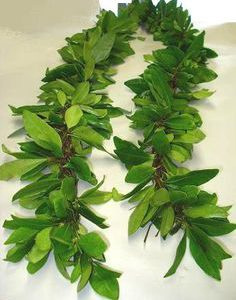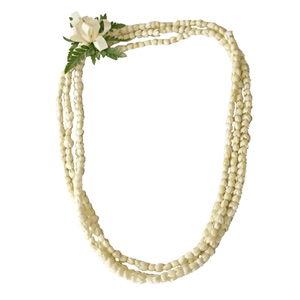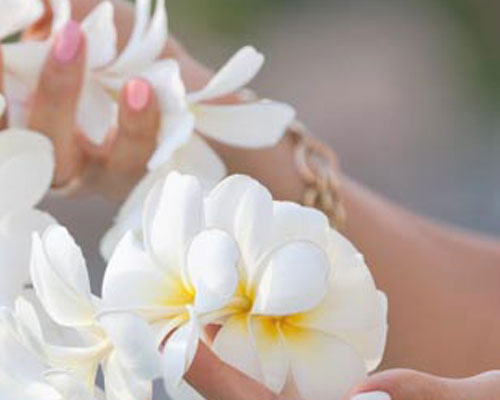A Hawaiian vacation is an adventure you will never forget. The crystal clear water, the gorgeous sunsets, incredible coasts lines, and the beautiful culture are fond memories you’ll look back on for years to come. How could your vacation possibly get any better? Well, with a customary lei greeting, of course! Imagine getting immersed in the culture of Hawaii and bless (Ho’omaika’i) your trip the moment that you step off of the plane… All you have to do is let us give you a customary lei greeting to you and all of your party. (808) 436-3744
The lei greeting tradition
Alongside the ukuleles and surfboards, lei are seen across the world as distinctly “Hawaiian”. The history of lei goes back to when a settlement of Polynesians arrived on the islands at some time roughly between 750 A.D. and the 1300s.
Throughout the history of the South Pacific, the Polynesian people would twine greens into types of wreaths and then adorn their bodies with those wreaths of vines and flowers to honor their gods. When the Polynesians sailed to Hawaii, they brought useful plants that they used for medicine, food, and building. They had also brought ginger ( or `awapuhi), a flower to be used for decoration and adornment.
From those early times, throughout the South Pacific and even some places in Asia, men and women would adorn themselves with the lei. Hawaii’s beautiful tropical environment offes a plethora of blossoms, leaves, and beads, allowing many variations of lei to be created to symbolize different meanings and life events. Throughout the centuries that the original Polynesian Hawaiians were isolated on the island, lei became a staple in their traditions.
Visitors love to receive a warm welcome and a lei greeting as they enter Hawaii. People love it simply because it is a lot of fun. It’s also a picture-perfect photo opportunity to kick off your tropical getaway.
Lei are a huge part of Hawaii culture and it’s often a lot of fun to partake in a different culture’s traditions. Even when it’s something as simple as letting a lei be placed on you. Also, no matter where you are coming from, the flight to Hawaii is a long one. Getting off the plane and experiencing something as bright, colorful, and pleasant as a lei greeting is a great way to forget all about that long flight and welcome you and your family to paradise.
While lei being used to greet visitors is a common use, they play a much larger part in Hawaiian culture. They are commonly used to celebrate birthdays, anniversaries, or graduations. Pictures of Hawaiian locals graduating will show their entire faces being covered from all of the lei being piled onto their necks! It is a very meaningful tradition. The Hawaiian lei is used to mark an important event in someone’s life, no matter how big or small. They are used for political, social community, personal, religious, and farming ceremonies.
Maile Lei

The only Hawaii native on this list, the vines of the scented maile plant are used to create this leafy lei. It’s most often worn open-ended and given on very important occasions, such as weddings or graduations.
Purple Orchid Lei

The bright and colorful orchid lei are one of the most popular lei. They’re sturdier than most other flowers, are long-lasting, can be dyed and have no scent, making it a lei that truly is perfect for every person and occasion.
Pikake Lei

These pretty and delicate flowers pack an aromatic punch—in fact, you can usually smell them before you see them. Though these flowers are known as the Arabian Jasmine to the rest of the world, it was called pikake (peacock) by Hawaii’s Princess Kaiulani, who lovingly named it after her favorite bird.
Puakenikeni Lei
The trumpet-shaped flower from the puakenikeni tree is one known for its strong, fragrant aroma. Introduced to Hawaii in modern times, it received its name puakenikeni (“10-cent flower”) locally, because each flower was once sold for 10 cents each in the early days when it was first used to make lei.
Tuberose and Ti Leaf Lei
The broad-leafed ti plant was a canoe plant brought to Hawaii with the early Polynesians. It’s a versatile plant used for medicine, shelter, clothing and food—and its leaves are woven together to create the ti leaf lei. Tuberose is native to Mexico and was introduced to Hawaii more recently, but was adopted by Hawaii’an culture ever since.
White Ginger Lei
This sweet smelling lei plant originated in India and was brought to the Hawaiian Islands with the early Polynesian settlers. This exquisite lei lies flat with its petals facing outwards, emanates a beautifully unforgettable scent.
Lei etiquette 101
- Never refuse a lei if someone presents it to you. It is considered rude.
- To wear a lei correctly, drape it on your shoulders, with half it hanging to the front and half to the back.
- Pregnant women should not wear a typical closed lei as it is believed to be bad luck. However, open-ended lei are considered appropriate.
- You will win the “Etiquette Award” from your friends and family by arranging a lei greeting at the airport by calling us at (808) 436-3744
Note: To ensure that we get your order exactly right lei greetings must be arranged by phone.

